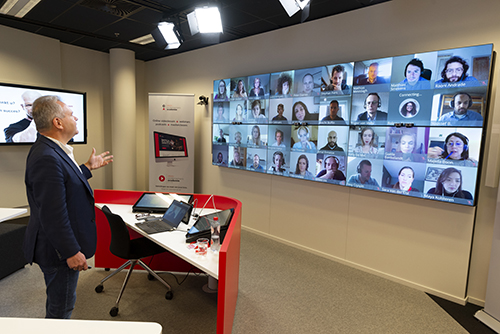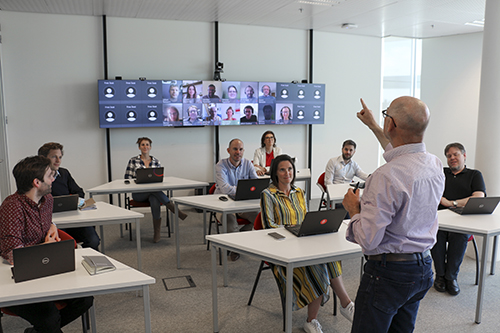The Critical Pivot From Classroom to Distance Learning
With shelter at home orders affecting organizations globally, including AVIXA® and many of its members, learning and education professionals have quickly figured out how to move their programs online. Here are a few takeaways for educators and the AV professionals who support them … that we’ve learned so far during this critical pivot from classroom to distance learning.
First, it is important to be clear on terminology. Distance learning is not just “online” learning, a format where lessons are recorded and made available for students to consume at their own pace with no help from an instructor or interaction with other students. Distance learning means holding a live class with an instructor and a limited number of students at a specific time. Distance learning is an attempt to create something as close to a true classroom experience as possible, without having to go to a specific location.
Both online and distance learning have a bad reputation with some in the learning community. Engagement and interactivity are pillars of modern instructional best practices and because those goals are not achieved by someone passively listening to a recorded lecture, some have discounted virtual learning. With a recorded online learning delivery, there is no way to know if the student focused on the content or simply played the video in the background while focusing on something else. However, a well-designed distance learning setup can address some of those concerns, and even has advantages over in-person delivery.
In the best case scenario for a distance virtual learning, the instructor will broadcast from a classroom or studio environment designed specifically for that purpose with a technology setup advanced enough that she can see all of the students as clearly as if they were in the same room. Breakout rooms will be available for students to work collaboratively in smaller groups, and instructors will have real-time analytics available on the engagement levels of every student in the class.

That’s what AV provider Barco aims to provide with its weConnect Virtual Classroom solution. These virtual classrooms allow every student in the class to see and hear each other seamlessly, as well as to share and cocreate content. Being entirely cloud-based also makes the system reliable and flexible. Ellen Van de Woestijne, Global Director of Strategic Marketing, Barco, says “We use technology platforms to enable you to reach the learning outcomes that you want.” She believes that it is important for learning organizations to have solutions in place for all types of instruction delivery: in-person, virtual, and online. The pandemic reinforces the point that relying on classroom only instruction is not practical. Systems like weConnect elevate the experience of students with high production values, a quality Van de Woestijne refers to as “when Hollywood meets Harvard.”
A major advantage to virtual over in-person learning is the ability to measure engagement. The instructor gets analytics on each student – the number of times they spoke, raised their hands, or answered poll questions. In addition, distance learning allows more students to join a course from disparate geographic locations.
The pivot to distance learning is about more than just figuring out the technology, lesson plans also must be adapted. AVIXA has moved several of its most popular AV training courses, like CTS® Prep and Networked AV Systems, from a classroom to a virtual delivery, and the association plans to move even more courses to virtual over the next few months. The AVIXA staff and volunteers who working on these transitions have already learned a lot of valuable lessons along the way.
Bob Higginbotham, AVIXA’s Director of Technical Training, says “Our classroom-based lesson plans were designed as eight-hour days. It was not reasonable to expect someone to sit at a computer that long and focus on something.” The team reworked all the lesson plans into four-hour classes instead. The AVIXA distance courses employ Zoom breakout rooms for small group work where students collaborate to solve a problem. Slack channels and virtual community spaces fill the void created when people miss the opportunity to chat at lunch breaks.
Higginbotham explained that pre-planning and communication become even more essential when delivering virtually. In a virtual class, ice breaker activities are more important than ever and require more planning. His biggest concern when rolling out the first virtual course was whether they had remembered to tell the instructors and students everything they needed to know.
Course materials are also a major consideration. Any item that would normally be handed physically to the student in a classroom has to be made virtual. This might be as simple as making all workbooks digital PDFs, or more complex, like researching a publicly available virtual calculator for the CTS Prep class, to function the same as the one students are provided when they sit for the CTS exam at a testing center. According to Higginbotham, there is already a plethora of apps and online tools available that can replace physical supplies and instruments in the classroom. He expects that in the future, most classes will be making greater use of these tools.

Overall, the AVIXA team finds that the technology is there to reliably deliver a virtual class; the larger challenge is in adapting their training materials and instructional techniques to work well in that format. So far, their hard work has paid off in very positive evaluations from the first batch of distance learning courses.
What we have learned over the last few months is that, while not everyone has access to it yet, the technology exists to make distance learning an effective reality, that lesson plans must be adapted, and it’s important to be prepared to go to a distance model. Even without the driving factor of a pandemic, there is an enormous opportunity to make educational opportunities available to more people than ever before through distance learning options – erasing some of the past geographic and financial barriers that have prevented some from receiving valuable training and education.






